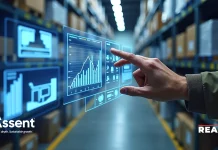Space exploration is always a topic that leads to innovations and technological advancements. In this context, aerospace robotics emerges as a novel approach that unlocks the full potential of space travel. From assembly to manufacturing, these robots handle all that the aviation industry needs help with.
So, let’s take a detailed look at the robotics that are shaping the aviation industry.
What is Aerospace Robotics?
Aerospace robotics refers to the use of robots and automated systems in the aerospace industry for various applications. These robots are designed to perform several tasks, such as manufacturing, assembly, inspection, material removal, and more, in the aerospace sector. From robotic arms to autonomous drones, a wide range of robots are widely used in the aviation sector.
The use of robotics in aerospace engineering has been growing, offering improved quality, reduced costs, increased productivity, and enhanced safety. According to Extrapolate, the aerospace robotics market is expected to be valued at $7.87 billion by 2030.
Benefits of Aerospace Robotics in the Aviation Industry
Robotics in aerospace offers several benefits, such as:
- It increases productivity and efficiency in aerospace manufacturing processes.
- It enhances precision and accuracy in assembly and manufacturing applications.
- It enhanced worker safety by automating hazardous or repetitive tasks.
- It helps in cost reduction through streamlined operations and optimizing resources properly.
- It helps improve quality and consistency in manufacturing processes.
- It assists aerospace robotics companies in maintenance and inspection, leading to improved aircraft safety and reliability.
- It offers flexibility and adaptability, allowing for rapid changes and customization.
- It makes exploration of space and other celestial bodies easy by using autonomous robots for research and data collection.
Exploring the Role of AI and Aerospace Robotics in Aerospace and Defense
The development of innovative technologies, particularly artificial intelligence and robotics in aerospace, contributes to overall technological progress. Let’s understand its role.
Artificial intelligence (AI) and aerospace robotics are significantly shaping the aerospace and defense sectors. AI algorithms and advanced robotic systems are streamlining the various complex tasks in these industries. AI enables autonomous decision-making and data analysis, optimizing flight operations, enhancing navigation systems, and improving maintenance processes.
On the other hand, robots, like drones, unmanned aerial vehicles (UAVs), and robotic arms, can help in defense strategies by providing surveillance capabilities, remote sensing, and targeted strikes. Artificial intelligence and robotics in aerospace and defense have increased efficiency, reduced costs, enhanced safety, and improved mission success rates. This combination of advanced technologies is paving the way for a profound future in aerospace and defense.
Are Aerospace Robotics the Key to Overcoming Challenges in the Aviation Industry?
Robotics in aerospace helps overcome several challenges in the aviation industry. Below are the key challenges that it is addressing:
● Improved Efficiency and Productivity
The aerospace industry faces the challenge of increasing productivity while maintaining high levels of precision and quality. Robotics, such as robotic arms, address this problem by streamlining the manufacturing and assembly processes, thus reducing production time and increasing efficiency.
Various companies are developing robots for the aerospace industry. Among them, Comau is a leading automation and robotics manufacturer. Its Aura collaborative robot assists humans in avoiding collisions during heavy-payload collaborative applications.
● Enhanced Safety and Risk Reduction
Safety is of utmost critical element in the aviation industry. Robotics in aerospace helps address safety challenges by taking over hazardous tasks that pose risks to human workers. Robots can handle tasks such as material removal, drilling, and inspection, reducing the potential for accidents and injuries. It can also access hard-to-reach areas of aircraft, improving safety during maintenance and repair operations.
To overcome these challenges, FANUC Robotics developed the CR-35iA robot. This cobot is designed to work safely alongside human workers without requiring safety fences. It can handle physically demanding tasks, such as heavy lifting, to assist aerospace robotics engineers in solving ergonomic challenges.
● Complex Manufacturing and Assembly
Aircraft manufacturing and assembly involve intricate processes and the handling of large and heavy components. Robotics solves these issues by providing precise and consistent manufacturing and assembly capabilities. Robots help in drilling, fastening, and riveting with high accuracy, ensuring the quality and integrity of the aircraft components.
In this context, Mitsubishi Electric‘s vertically articulated robots claim to overcome this complexity in the aviation industry. The robot can handle machine-tending, assembly, packing, and tray-handling.
The Future of Aerospace Robotics: What Lies Ahead?
The future of aerospace robotics looks promising with the continued advances in this field. Leading players like NASA play a significant role in the development and implementation of robotics in aerospace. The agency is currently involved in testing and deploying autonomous space robots for various purposes.
Its project, ARMADAS (Automated Reconfigurable Mission Adaptive Digital Assembly Systems), focuses on developing autonomous robots capable of constructing structures on the moon and Mars using local resources. The ARMADAS team is working on increasing the equipment used for deep space exploration missions, allowing robots to disassemble structures and construct future designs.
Browse More Posts:-
Aerospace Titanium Market
Automotive Windscreen Glazing Market
Sauerkrauts Market
Agricultural Supply Chain Service Market




